The Theatre of Dreams has waited long enough for a huge Champions League clash exactly like the battle between Manchester United and Barcelona. Unfortunately, despite their valiant efforts, the Red Devils will have to chase their dreams even harder next week. The Catalans left Manchester with a victory, a clean sheet and that crucial away goal that more often than not makes the difference in the very end.
Still, the hosts can take pride in a stellar performance which put Barcelona on the back foot for the majority of the game. Their woeful finishing, however, meant that the result left their fans and themselves with a lot more to be desired. There will, no doubt, be some fine bookmaker promotions available for the second leg next week.
This tactical analysis will use statistics to dissect the game that surprised us in many ways bar the end result, and kept us on our toes for the whole 90 minutes – just like a true clash of titans should.
Lineups
Manchester United (5-3-2)
Starting XI: De Gea – Young, Smalling, Lindelöf, Shaw – Fred, McTominay, Pogba – Dalot, Lukaku, Rashford
Bench: Romero, Jones, Rojo, Andreas, Lingard, Mata, Martial
Coach: Ole Gunnar Solskjær
Barcelona (4-3-3)
Starting XI: Ter Stegen – Semedo, Piqué, Lenglet, Alba – Rakitić, Busquets, Arthur – Messi, Suárez, Coutinho
Bench: Cillessen, Umtiti, Vidal, Aleñá, Sergi, Malcom, Dembélé
Coach: Ernesto Valverde
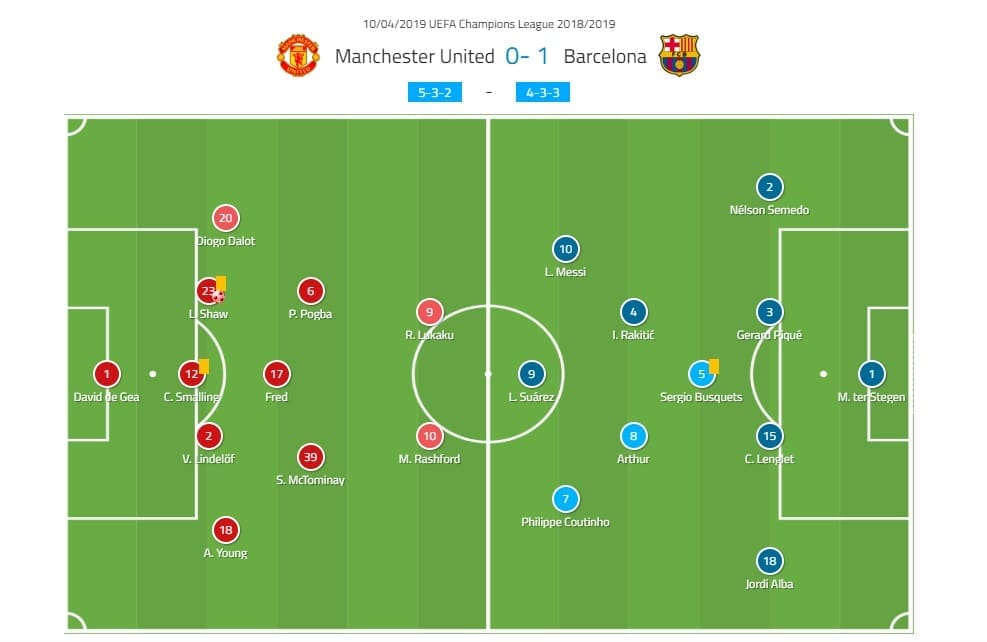
Barcelona’s setup
Having played three extremely difficult matches in just over a week, including a 4-4 goal-fest against Villarreal and an (almost) title-clinching victory over Atlético Madrid, Barcelona had no real time to rest, recuperate or rotate the squad. With all the emphasis this year being on the coveted Champions League, Ernesto Valverde brought his strongest lineup to Manchester.
The usual questions were posed before the game, and the answers provided were planned as much as they were a necessity. Nélson Semedo was deployed at right-back to inject some blistering pace to a traditionally slow Barcelona defence, and Philippe Coutinho got the chance to play against his former bitter rivals once more, leaving the recovering Ousmane Dembélé on the bench.
Under normal circumstances, the Frenchman would most likely start ahead of the Brazilian but Valverde did not want to risk aggravating the injury again, even though Dembélé received the medical green light the day prior to the clash.
No other surprises were found on the Catalan side of Old Trafford as the away team opted for a 4-3-3 formation that was slightly altered in the second half in order to stabilise the game.
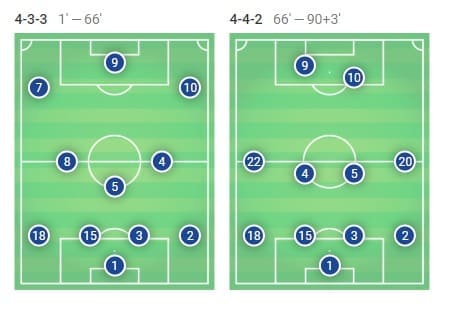
Manchester United’s setup
As far as the injury list goes, Ole Gunnar Solskjær was definitely in a worse position than his Basque counterpart in the opposite camp. Six players are out injured, including the likes of Ander Herrera, Nemanja Matić and Alexis Sánchez, some of whom are definitely big pieces of the Manchester United puzzle.
Still, when it comes to putting a strong XI out on the field, Solskjær did not have to think much in order to compose what is looking like their best lineup, all things considered. With Eric Bailly out with a head injury, it was obvious that a centre-back pairing of Victor Lindelöf and Chris Smalling would be deployed in front of David de Gea. Ashley Young and Luke Shaw graced the wide areas of that backline with Diego Dalot dropping to make it a quintet when necessary.
A midfield trio of Paul Pogba, Scott McTominay and Fred was tasked with keeping Barcelona at bay, while Romelu Lukaku and Marcus Rashford formed the attacking duo.
Manchester United started off in a more defensive manner, operating in a 5-3-2 formation, but quickly swapped to 3-5-2 at the beginning of the second half, and held it until the very end of the game.
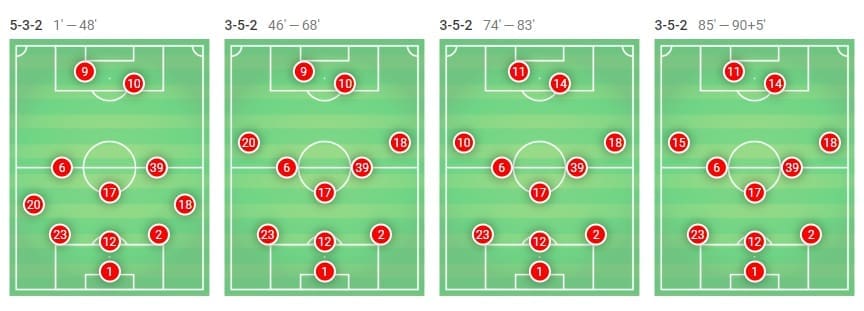
Barcelona start strong but fall off shortly after
The main narrative before the game was that Barcelona would dominate the game and the ball while Manchester United would sit back and rely on quick transitions to get a couple of golden opportunities. While it did seem like the match would indeed unfold that way, just like with every good story there was a twist waiting around the corner.
Yes, at first, United struggled to get the game under their control as Barcelona had a hectic start, pushing the red shirts back and forcing them to defend in the opening stages of the game. When the scoreline was level, United were happy to stay in their compact shape and a wide backline of five in a 5-3-2 system. This resulted in Barcelona having a total of 85.4% possession after the first 10 minutes, pinning Manchester United into their own half and claiming 62.5% of the territory.
The home team had a pretty interesting setup to counter Barcelona, and it seems that Ole Gunnar Solskjær had taken a page out of Diego Simeone’s book. The main strategy to dampen the Catalans’ usually sharp attack was to create overloads across the pitch and force Barcelona wide.
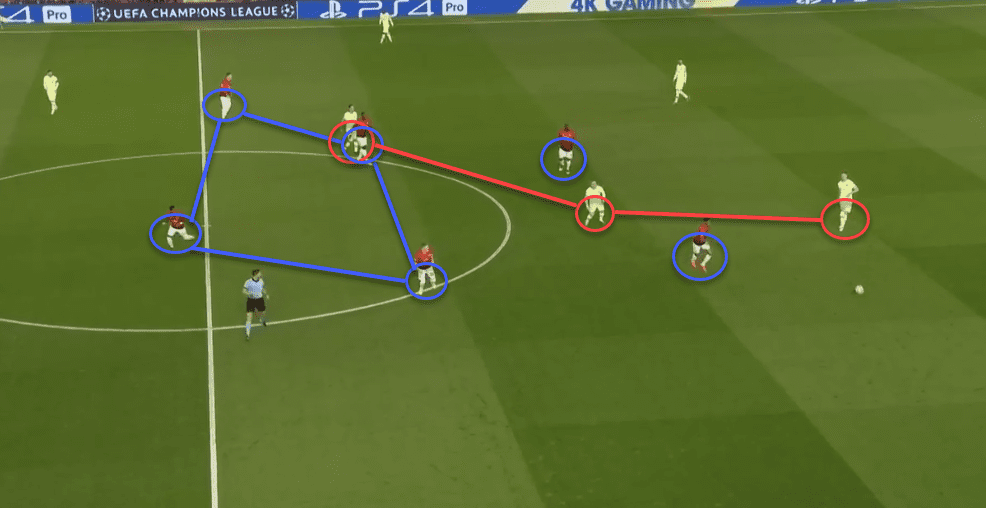
A pretty interesting diamond-shaped midfield was used to block Barcelona’s entrances into the opposition’s half in a relatively high block that aimed to put Barca’s backline under pressure. If that block was breached, however, Manchester United would quickly default to their 5-3-2 formation, as Diogo Delot would drop deeper to support the backline, and another overload would be created.
Note in the image above how Barcelona’s midfielders are well covered and the channels leading to them through the middle are all closed. Then, as Barcelona advance through the wings, since there was rarely any chance to do so through the middle, United follow suit and move their shape to a more defensive-minded one. In these situations, they prioritised a numerical superiority around the edge of their own box, especially covering zone 14.
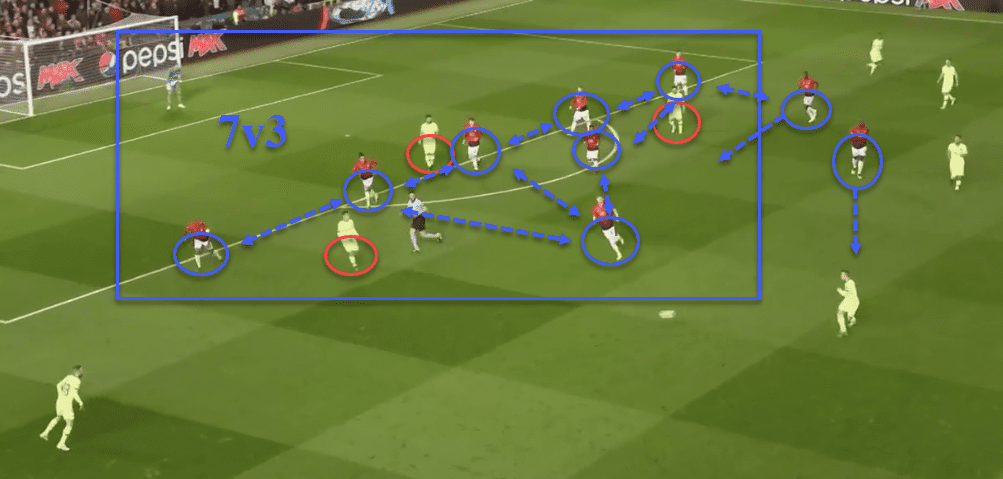
In the example above we can clearly see how Barcelona’s forward trio are literally drowned in the sea of red shirts who make it a pretty unfair 7v3 fight. This meant that Messi had to drop much, much deeper in order to receive the ball, and what was even more impressive for Manchester United, he only received a single ball in the opposition’s box throughout the whole 90 minutes of the game.
A similar thing happened to both Luis Suárez and Philippe Coutinho, as can be observed in the graph below showcasing the received passes of Barcelona’s trident up front. Suárez and Coutinho had zero balls passed to them inside United’s box and Suárez, who was the main target in the danger zone, lost all four of the attempts to get in front of de Gea.

With that compact structure keeping them from creating anything dangerous to threaten their hosts, Barcelona relied on space manipulation to get past the block in front of them. Catching Manchester United in transition was not likely, even though at times Dalot did leave space for Semedo to burst into when he was caught positioned higher up the pitch.
Those chances were scarce and even if the ball found itself going into the box, there were far too many bodies covering it for Barcelona to make an impact. Instead, they needed to shuffle the backline quintet and move them out of position, just like they did against Atlético Madrid at the weekend.
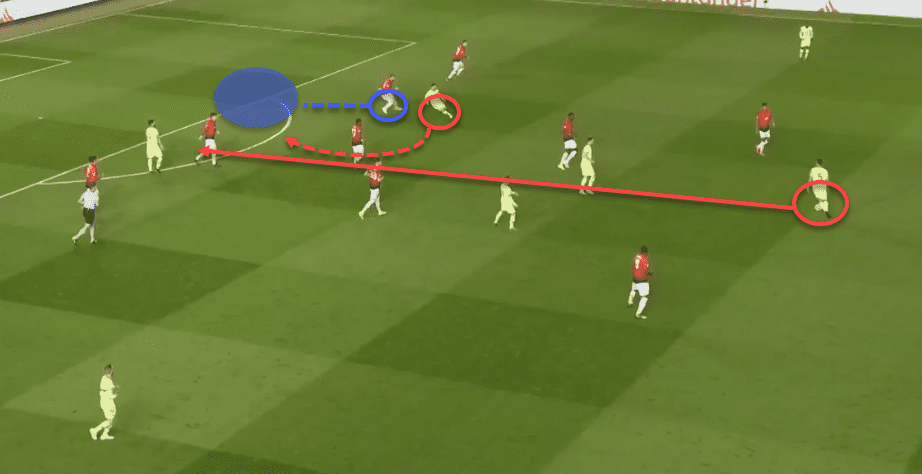
We’ve already established how Barcelona’s front three were extremely tightly marked but this was especially true for Lionel Messi, who sometimes had up to three defenders following his every step. As we have seen him do before, Messi used that man-marking against Manchester United, which can be seen in the image above.
The Argentine notices that Luke Shaw was on his tail so he lures him in deeper, making him step out of his position in the backline. A sudden twist and a characteristic burst of speed lets Messi glide past the young defender and through the newly created pocket of space, where he receives a fantastic ball from Sergio Busquets. As we already know, that attack yielded Barcelona their only goal, and what turned out to be the winner on the night.
Manchester United take the reins and fight back
Ever since Barcelona managed to get that crucial goal, the Catalans seemed to take the foot off the pedal just a bit, but it was enough for Manchester United to show their own quality. From that moment onward the game shifted from United’s half to Barcelona’s and that’s where it remained for the majority of the next 45 minutes at Old Trafford.
Suddenly, Barcelona stopped applying as much pressure. Be it due to tired legs, switching to a defensive mindset or simply not being able to deal with Manchester United’s newfound energy, the Catalans dropped to their 4-4-2 mid-block and were adamant in not letting anything get through.
Coincidently, though, just as one side stopped their press, the other side’s press was triggered and in what seemed like a split of a second, numerous red shirts were in Barcelona’s face. There are two ways of successfully countering the Blaugrana: you either sit back, soak up the pressure and exploit the space behind their backs on counters, or you fight fire with fire, which is exactly what Manchester United did.
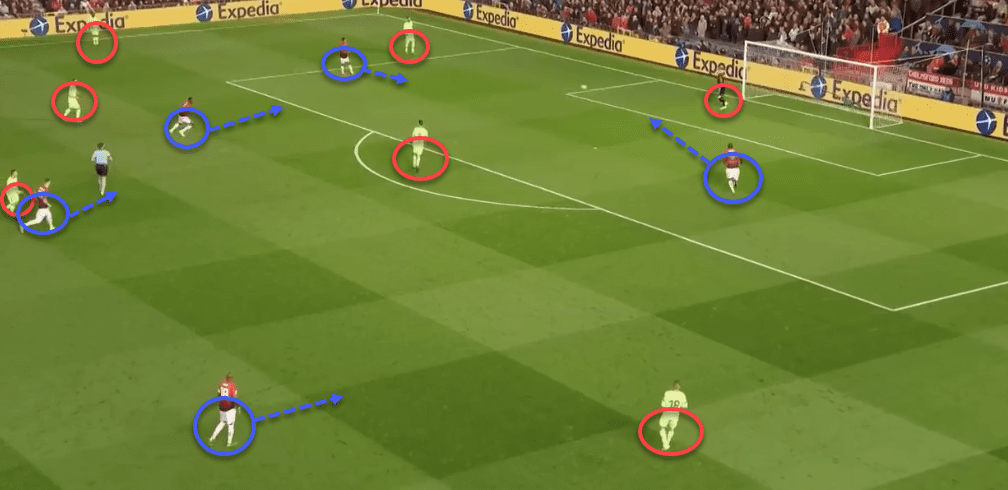
United were pressing really hard and with plenty of intent. They blocked all the passing channels, smothered the midfield options and forced Barcelona, or namely their centre-backs and Marc-André ter Stegen, to rely on long balls and clearances to get out of sticky situations.
The key was to stop Barcelona from playing from behind, and that was achieved successfully. If we take a look at Gerard Piqué and Clement Lenglet, we can see that their long-ball output was significantly weaker in the second half of the game. The Frenchman completed only two out of seven in total, and a result of the press was only presented with two chances in the second half, one of which was a failed attempt.
Piqué failed with two out of three long passes while the goalkeeper himself made two errors out of four total attempts in the second half.

But what made Manchester United’s press even more efficient was the fact that they could easily collect all loose balls. They won most of the duels, especially aerial ones, once Barcelona decided to just clear the ball towards their front line.
The hosts switched their formation once more, this time assuming a 3-5-2 and pilling men forward as much as possible. Since Barcelona left Suárez and Messi without many defensive tasks, and the rest were turtled up in their own half, it felt like they got the worst of both situations.
Playing out of the back was extremely difficult with such a well-executed and relentless press. Counting on a fast break was also not likely since they could only count on Messi and Suárez, both of whom were closely marked.
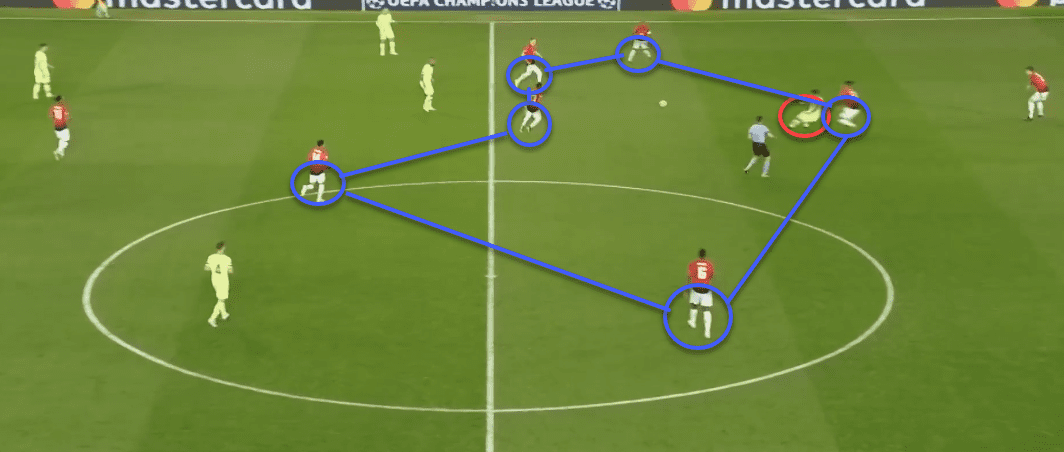
As a result, all the long balls were either intercepted or quickly taken away from Suárez as he would so often find himself surrounded by at least two players upon receiving the ball, as seen above. And this is exactly what United were counting on as the press yielded them an uncharacteristic number of losses of the ball by Barcelona.
A total of 84 were recorded on the night and a staggering 44% happened in Barcelona’s first third. Three directly led to shots on goal, as depicted in the graphic below, along with Manchester United’s interceptions.

A benign dominance
The reason why Manchester United were able to control the game was due to the excellent press but also due to them having a clear physical advantage up front. Romelu Lukaku would regularly receive the ball, hold up play and then lay it off for one of his sprinting teammates. This was a luxury Barcelona did not have at any point throughout the match. Since the hosts were playing in a high defensive line and pilling men up front, winning the first and the second balls would always spell danger for their opponents.
It was a simple move that would start with David de Gea sending a long ball to Lukaku, who then tamed it under pressure, keeping his markers at bay before sending it further up he field. United had multiple options almost at all times since they moved the majority of their personnel into Barcelona’s half of the pitch.
The main idea, however, was to create overloads on the flanks and get into good crossing positions as their supremacy in the air was so evident. In this aspect, Manchester United did all of the steps correctly and successfully bar the very last one: finishing.
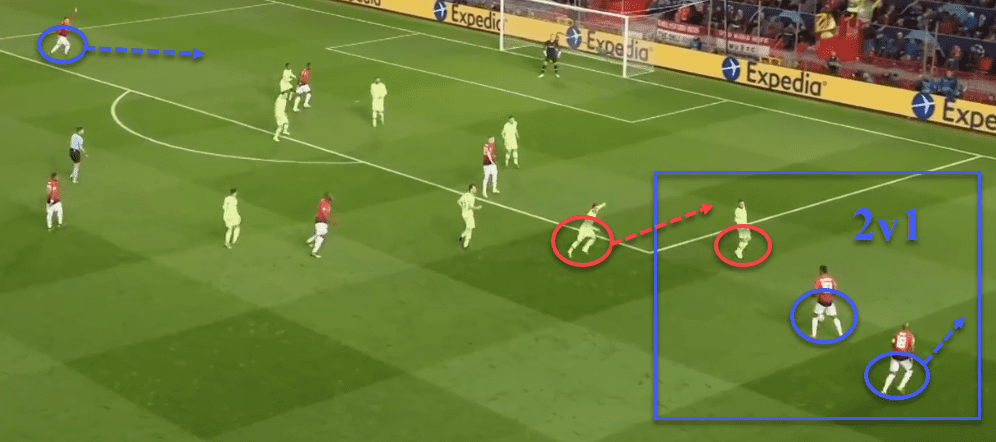
Notice in the example above how United are in a great 2v1 position on the flank which keeps Alba from committing to a tackle until support arrives. The hosts can use the overlap or cross it instantly, but just the option of a supporting runner means that Alba allows them to get on with the cross that led to what was most likely their best opportunity in the game.
In the attacking phase, United would move Dalot and Young extremely high up the pitch and use them as width providers, leaving only three men in the back. This allowed them to get into advantageous positions on the wings with constant doubling up and overlapping. A direct result is the total number of 21 crosses. To their own disappointment, only three were accurate.
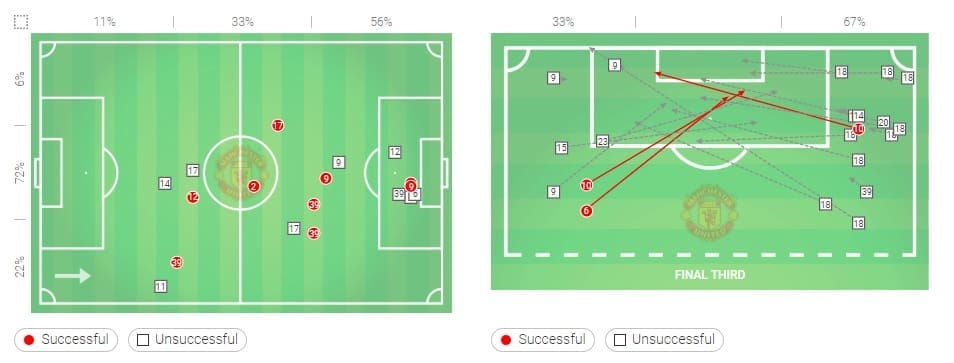
They did, however, win most of their aerial duels but could not capitalise on any of the crosses into the box from wide areas. Not only that, but Manchester United failed to have a shot on target in a Champions League game for the first time since March 2005, in a 1-0 defeat against AC Milan.
It was a truly astonishing feat, both for the Red Devils to keep the record alive for so long and for Barcelona to break it in a game that was seen as a weak performance. But that can be extremely misleading. Yes, the Catalans were on the defensive much more than anticipated, but as much as this could have been reminiscent of that night in Rome, this was a completely different story altogether.
Barcelona stay calm and weather the storm in style
In general, Ernesto Valverde once again opted for his characteristic pragmatic approach with the emphasis on low risk-taking and a careful step-by-step kind of plan. Getting the away goal was vital and Barcelona were happy enough to sit out the game and let Manchester United dictate play.
Part of that was under their own control and by their own choice but they did not expect United to come out all guns blazing. Their opponents’ approach made them flinch, lose the ball on one too many occasions and finally let the hosts through with some pretty good chances.
But at the end of the day, the doors were closed shut and Marc-André ter Stegen, as much as he had to stay vigilant for the whole 90, did not have to do an awful lot of saving on the night. So how did Barcelona lock the door and throw the key away?
Simple, and via three key components: defensive solidity, gigantic Gerard Piqué and Nélson Semedo performances and, once again, a stroke of brilliance from Valverde with both the substitutes and the general strategy. But let’s start at the beginning.
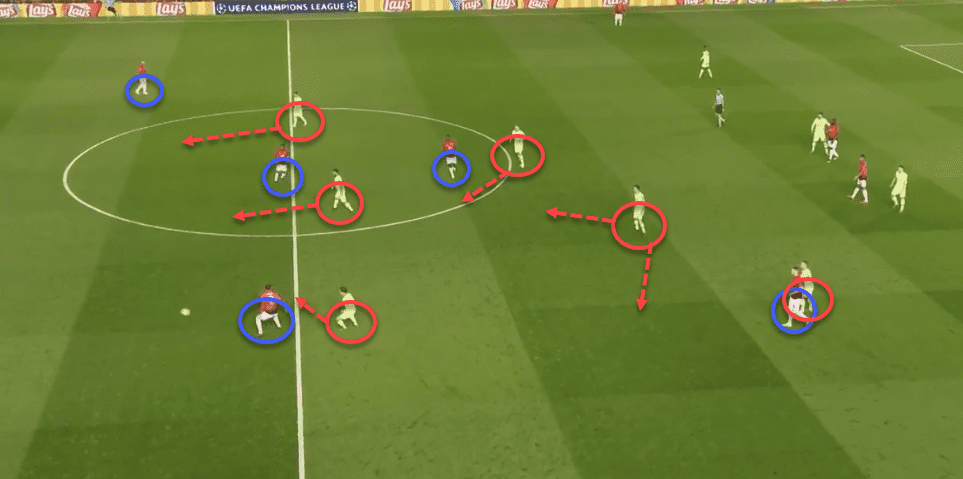
They might have not pressed with the same intensity throughout the whole game but when they did, it was very well orchestrated, as it usually is when it comes to Barcelona. Defending long balls to Lukaku proved to be difficult, and stopping United from crossing constantly was also a tall task, but the hosts were only ever allowed to do so much, which proved not to be nearly enough.
Notice above how Barcelona use a mid-block to stop United from advancing just as well as they would’ve in a really high-pressing situation but with arguably less effort. The passing channels are closed and the hosts’ attempts are repelled.
When you add Piqué’s numbers to the tally, that solidity becomes that much more evident. The Spaniard was kept busy but he did his job outstandingly well with nine clearances, five duels won, a crucial goal-preventing tackle, five interceptions, 12 recoveries and a 94% passing accuracy.
Finally, once the game was slipping away from Barcelona and Manchester United were looking even more dangerous at the beginning of the second half, it did not take Valverde too long to ponder what changes he had to make.
The incorporation of Sergi Roberto and Arturo Vidal in favour of Arthur and Philippe Coutinho meant that Barcelona would switch to a 4-4-2, and balance would once again be restored, and emphasis would swap back onto the midfield.
Busquets would still drop deeper to the lavolpiana position between the centre-backs but would now have more support in front when necessary, and the numerical superiorities were diminished.
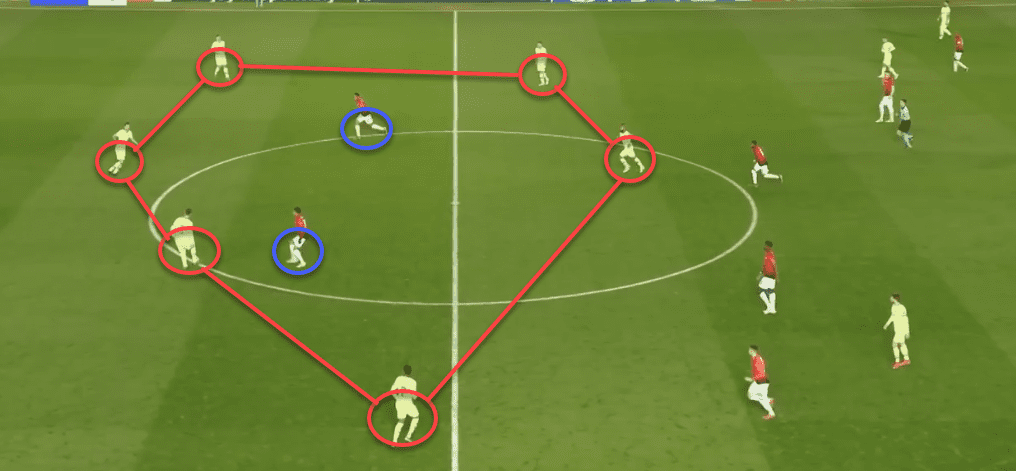
When building from the back, Barcelona had three men against one or two at most, and in midfield, they had either five players and, at times, when Messi dropped back, even six. What ensued after that was a long game of rondo, just like in the training grounds, and United couldn’t even touch the ball until the final whistle was heard.
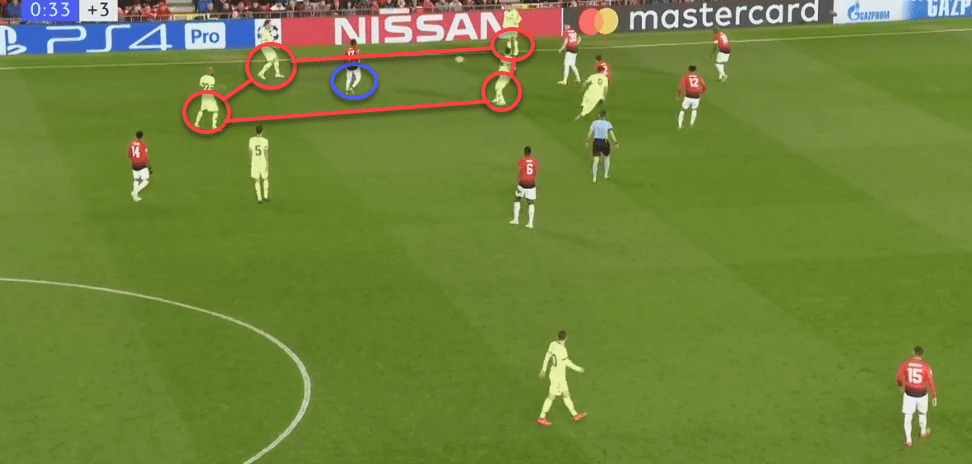
Once they managed to balance things out, keep their cool and regain control, it was just a matter of closing the game out with possession and inflicting frustration on their opponents.
Barcelona’s possession stats clearly indicate how the tides shifted throughout the game. The Catalans were on top at the beginning and the end while the English side had their fair share of dominance through the middle, which is when Barcelona had much less of the ball.
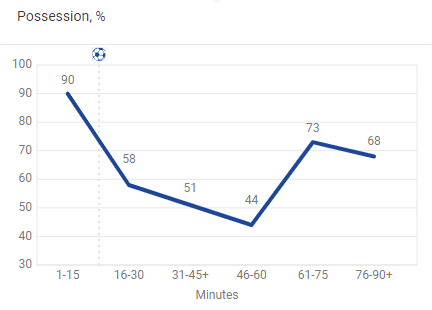
Conclusion
Even though it was described as a disappointing result for Barcelona considering the way they played, and how they got dominated by Manchester United, the truth is still somewhere in between. Not only was this their first win at Old Trafford, but it also came with a clean sheet and a crucial away goal in hand.
The hosts were definitely more proactive but their dominance yielded them little to speak off bar the courageous attempts against the favourites in general. However, no shots on target, no goals and an xG value of 0.32 (vs Barcelona’s 0.6) will partially confirm the slightly skewed narrative.
Still, this game was far from what it was predicted to be. An extremely one-sided affair turned into a real epic encounter of two absolute heavyweights of world football, and that makes the next week’s second leg that much more anticipated.
If you love tactical analysis, then you’ll love the digital magazines from totalfootballanalysis.com – a guaranteed 100+ pages of pure tactical analysis covering topics from the Premier League, Serie A, La Liga, Bundesliga and many, many more. Pre-order your copy of the April issue for just ₤4.99 here, or even better sign up for a ₤50 annual membership (12 monthly issues plus the annual review) right here.

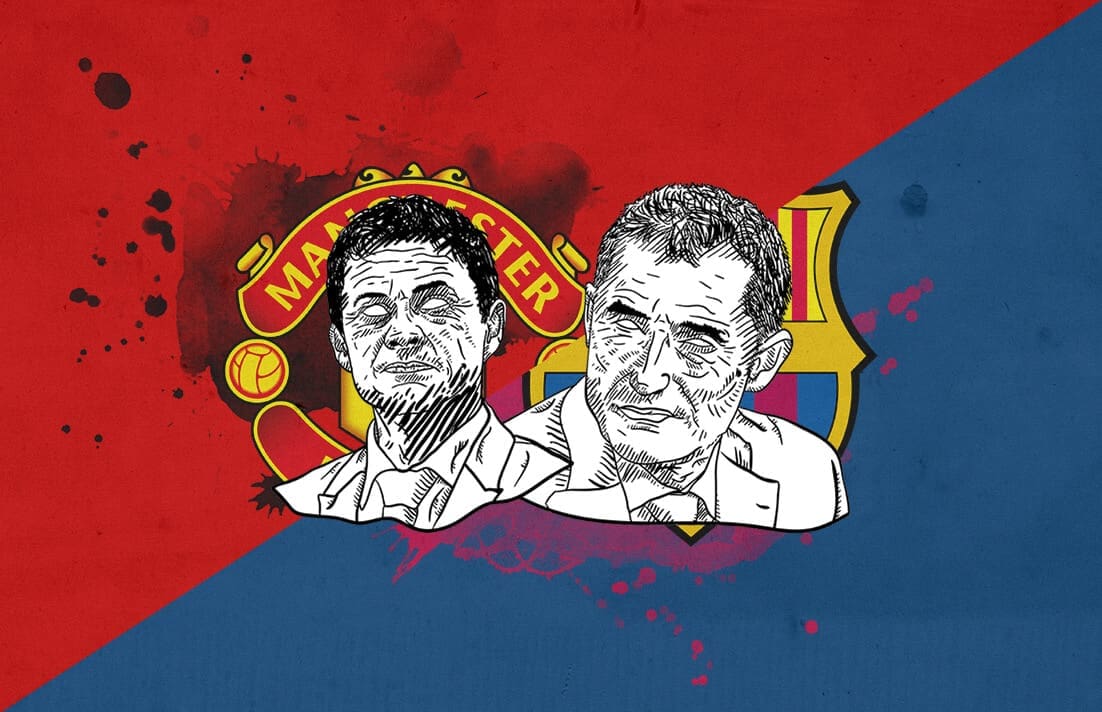




Comments